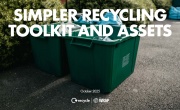Circular construction could reduce Scotland’s carbon footprint by 11.5 per cent
Making Scotland’s construction industry more circular could reduce overall material use by 11.2 per cent and its carbon footprint by 11.5 per cent, according to a Zero Waste Scotland (ZWS) protocol report.
 In its Circularity Gap Report (December 2022), ZWS states that Scotland will not transition to a circular economy without ‘sweeping changes in the built environment and construction sector. Currently, built environment contributes 50 per cent of Scotland’s overall waste.
In its Circularity Gap Report (December 2022), ZWS states that Scotland will not transition to a circular economy without ‘sweeping changes in the built environment and construction sector. Currently, built environment contributes 50 per cent of Scotland’s overall waste.
The report also finds that only 1.3 per cent of the resources Scotland uses are cycled back into the economy, with over 98.7 per cent of Scotland's material use coming from virgin sources. Scotland's per capita material footprint is nearly double the global average.
The new report (Site Waste Reduction Protocol) – released yesterday (16 February) was designed by industry specialists and is accompanied by an excel-based calculator tool designed to tackle material waste in construction.
The protocol is a set of rules for measuring site waste in a standardised way to achieve a consistent and comprehensive picture of how much waste is being produced across construction sites. It aims to assist in the creation of benchmarks within the construction sector and allow for good practice to be measured.
The accompanying calculator tool aims to reduce site waste by making it easier to measure, quantify, factor in the cost to the business, prevent future losses and measure a business’s carbon footprint. The protocol includes methods for the best use of the calculator tool for accurate results.
Alongside reducing waste, ZWS says a ‘big win’ for the construction sector would be to keep materials in circulation for longer through more modular building design and designing materials to be easy to disassemble and reuse.
Zero Waste Scotland's Stephen Boyle commented: "The Circular Gap Report shows us in no certain terms how much of a problem material waste is for the construction sector, but it can be hard to know where to start in tackling it effectively.
“The Site Waste Reduction Protocol sets out a simple and robust method for getting a comprehensive picture of what materials are being wasted and where, and which ones are costing you the most financially and environmentally.
“This allows construction professionals to target action on specific materials, and do it based on their either financial or environmental priorities."








